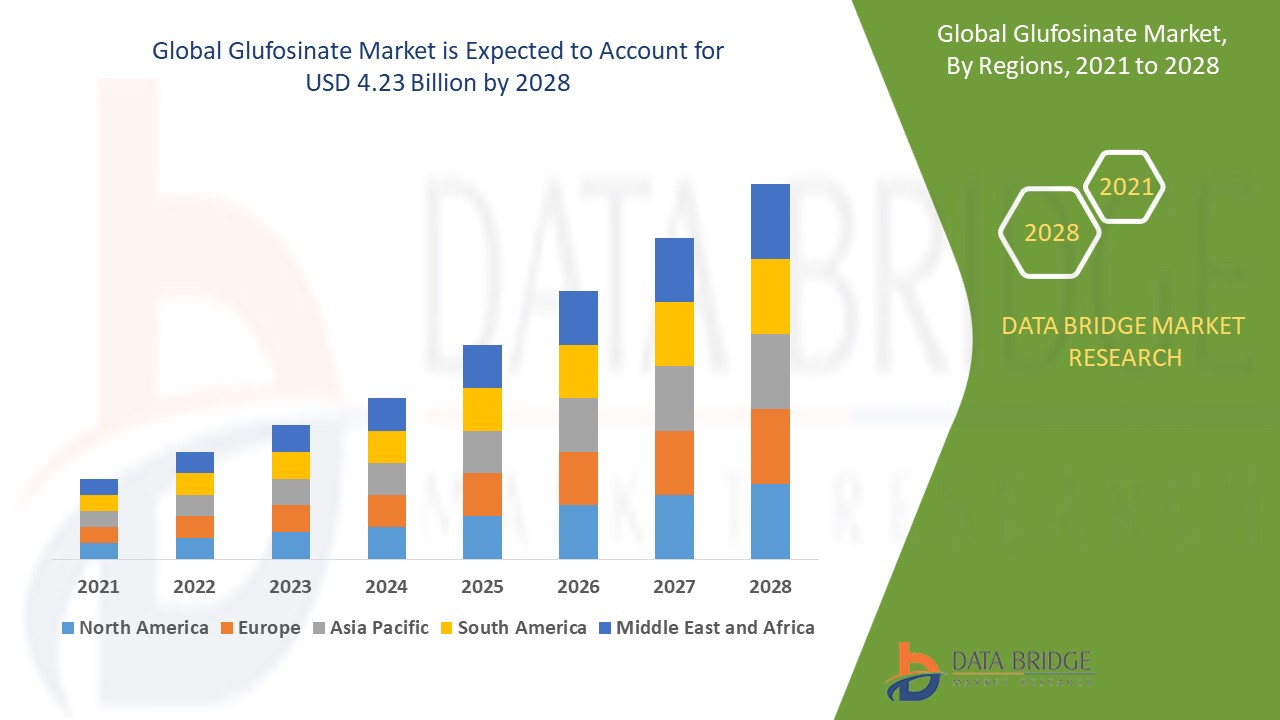Global Glufosinate market, By Crop Type (Cereals & Grains, Oilseeds & Pulses, Fruits & Vegetables, Others), Formulation Type (Aqueous Suspension, Liquid, Suspension Concentrate, Soluble (Liquid) Concentrate, Others), Country (U.S., Canada, Mexico, Germany, Sweden, Poland, Denmark, Italy, U.K., France, Spain, Netherland, Belgium, Switzerland, Turkey, Russia, Rest of Europe, Japan, China, India, South Korea, New Zealand, Vietnam, Australia, Singapore, Malaysia, Thailand, Indonesia, Philippines, Rest of Asia-Pacific, Brazil, Argentina, Rest of South America, U.A.E, Saudi Arabia, Oman, Qatar, Kuwait, South Africa, Rest of Middle East and Africa) Industry Trends and Forecast to 2028.

Market Analysis and Insights : Global Glufosinate Market

Glufosinate market is expected to reach USD 4.23 billion by 2028 and grow at a rate of 8.00% in the forecast period 2021 to 2028 Rise in the steady expansion of use of herbicide-tolerant crops acts as the vital factor escalating the demand for glufosinate market in the forecast period of 2021- 2028.
Glufosinate is defined as a highly efficient herbicide which is used to control broad ranges of weeds and also in the diseases on more than 100 crops globally. Farmers depend on glufosinate herbicide as it ensures more protection, as it works only on the applied part of the plant.
Increase in the demand for glufosinate as a substitute for glyphosate and paraquat is the major driver escalating the market growth, also increase in the demand for glufosinate as a substitute for glyphosate and paraquat and rise in the herbicide contribution in securing food bowl are also the factors driving the glufosinate market growth. Moreover, rise in the rapid growth in the glufosinate market and rise in the research and development activities in the market will further create new opportunities for the glufosinate market manufacturers in the forecast period of 2021- 2028.
However, toxic effects of glufosinate are the major factor among others acting as a restraint, and will further challenge the growth of glufosinate market in the forecast period.
Glufosinate market report provides details of new recent developments, trade regulations, import export analysis, production analysis, value chain optimization, market share, impact of domestic and localised market players, analyses opportunities in terms of emerging revenue pockets, changes in market regulations, strategic market growth analysis, market size, category market growths, application niches and dominance, product approvals, product launches, geographic expansions, technological innovations in the market. To gain more info on glufosinate market contact Data bridge market research for an Analyst Brief, our team will help you take an informed market decision to achieve market growth.
Glufosinate Market Scope and Market Size
Glufosinate market is segmented on the basis of crop type and formulation type. The growth among various segments helps in the better analyzation of growth and strategies for better vision of market.
- On the basis of crop type, glufosinate market is segmented into cereals & grains, oilseeds & pulses, fruits & vegetables and others.
- Based on formulation type, the glufosinate market is segmented into aqueous suspension, liquid, suspension concentrate, soluble (liquid) concentrate and others.
Glufosinate Market Country Level Analysis
Glufosinate market is analyses and market size, volume information is provided by country by crop type and formulation type as referenced above.
The countries covered in glufosinate market report are U.S., Canada, Mexico in North America, Germany, Sweden, Poland, Denmark, Italy, U.K., France, Spain, Netherland, Belgium, Switzerland, Turkey, Russia, Rest of Europe in Europe, Japan, China, India, South Korea, New Zealand, Vietnam, Australia, Singapore, Malaysia, Thailand, Indonesia, Philippines, Rest of Asia-Pacific (APAC) in Asia-Pacific (APAC), Brazil, Argentina, Rest of South America as a part of South America, UAE, Saudi Arabia, Oman, Qatar, Kuwait, South Africa, Rest of Middle East and Africa(MEA) as a part of Middle East and Africa (MEA).
Asia-Pacific dominates the glufosinate market due to large consumption of glufosinate ammonium in the agrochemical industry in this region. North America and Europe are the expected region in terms of growth in glufosinate market due to increase in the demand for glufosinate as a substitute for glyphosate and paraquat.
The country section of the glufosinate market report also provides individual market impacting factors and changes in regulation in the market domestically that impacts the current and future trends of the market. Data points such as consumption volumes, production sites and volumes, import export analysis, price trend analysis, cost of raw materials, down-stream and upstream value chain analysis are some of the major pointers used to forecast the market scenario for individual countries. Also, presence and availability of global brands and their challenges faced due to large or scarce competition from local and domestic brands, impact of domestic tariffs and trade routes are considered while providing forecast analysis of the country data.
Glufosinate Market Share Analysis
Glufosinate market competitive landscape provides details by competitor. Details included are company overview, company financials, revenue generated, market potential, investment in research and development, new market initiatives, global presence, production sites and facilities, production capacities, company strengths and weaknesses, product launch, product width and breadth, application dominance. The above data points provided are only related to the companies’ focus related to glufosinate market.
The major players covered in the glufosinate market report are present Bayer AG, Syngenta, LIER Chemical Co., Ltd, ChemicalBook, Corteva and Veyong among other domestic and global players. Market share data is available for Global, North America, Europe, Asia-Pacific (APAC), Middle East and Africa (MEA) and South America separately. DBMR analyst understands competitive strengths and provides competitive analysis for each competitor separately.
SKU-

